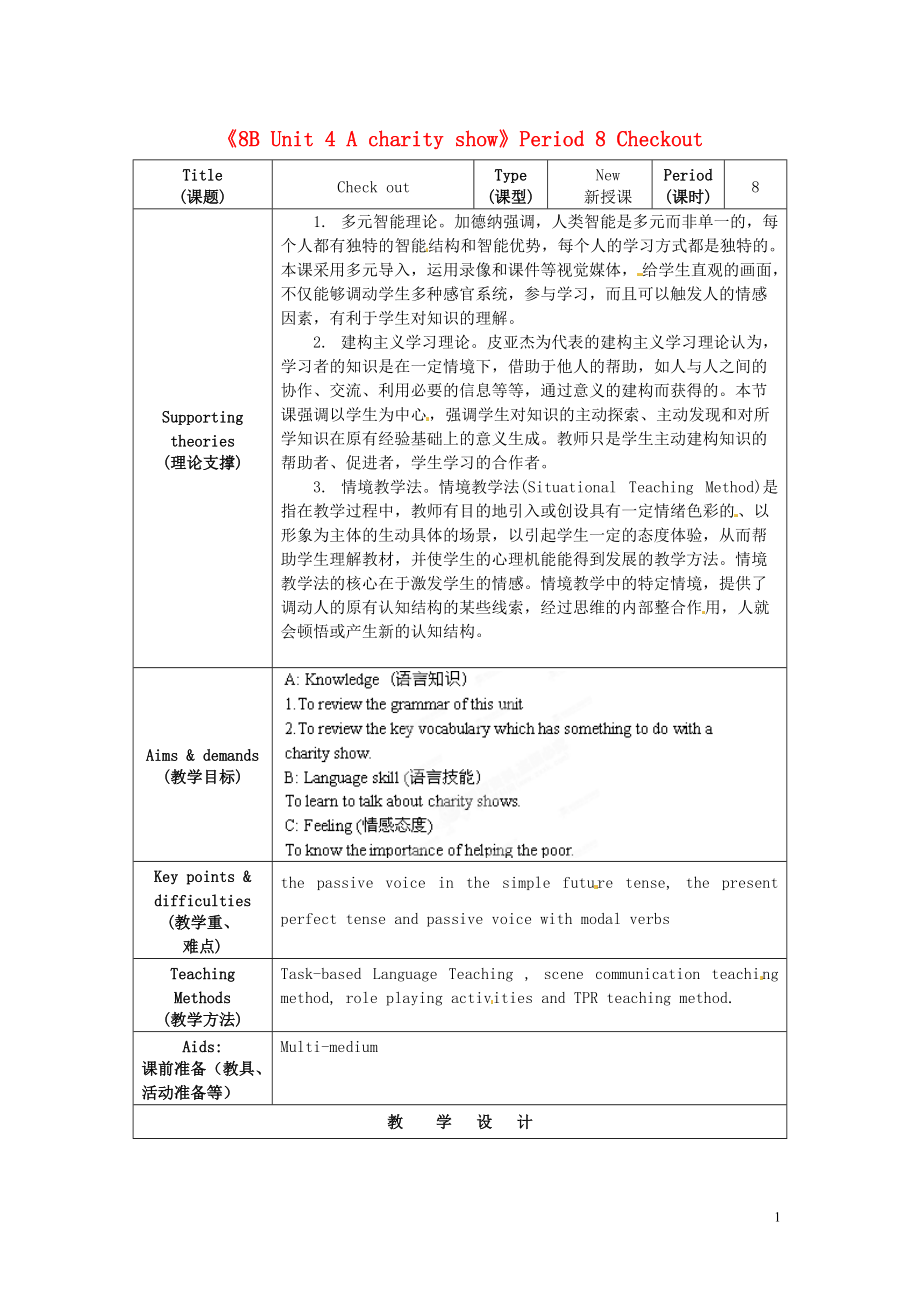《初級(jí)中學(xué)八年級(jí)英語下冊(cè)《8B Unit 4 A charity show》Period 8 Checkout教案 牛津版》由會(huì)員分享��,可在線閱讀���,更多相關(guān)《初級(jí)中學(xué)八年級(jí)英語下冊(cè)《8B Unit 4 A charity show》Period 8 Checkout教案 牛津版(3頁(yè)珍藏版)》請(qǐng)?jiān)谘b配圖網(wǎng)上搜索�����。
1�����、
《8B Unit 4 A charity show》Period 8 Checkout
Title
(課題)
Check out
Type
(課型)
New
新授課
Period
(課時(shí))
8
Supporting theories
(理論支撐)
1. 多元智能理論�。加德納強(qiáng)調(diào),人類智能是多元而非單一的�����,每個(gè)人都有獨(dú)特的智能結(jié)構(gòu)和智能優(yōu)勢(shì)�����,每個(gè)人的學(xué)習(xí)方式都是獨(dú)特的���。本課采用多元導(dǎo)入���,運(yùn)用錄像和課件等視覺媒體,給學(xué)生直觀的畫面���,不僅能夠調(diào)動(dòng)學(xué)生多種感官系統(tǒng)���,參與學(xué)習(xí)�����,而且可以觸發(fā)人的情感因素��,有利于學(xué)生對(duì)知識(shí)的理解����。
2. 建構(gòu)主義學(xué)習(xí)理論��。皮亞杰為代表的建構(gòu)
2���、主義學(xué)習(xí)理論認(rèn)為,學(xué)習(xí)者的知識(shí)是在一定情境下����,借助于他人的幫助,如人與人之間的協(xié)作�、交流、利用必要的信息等等�����,通過意義的建構(gòu)而獲得的�。本節(jié)課強(qiáng)調(diào)以學(xué)生為中心�,強(qiáng)調(diào)學(xué)生對(duì)知識(shí)的主動(dòng)探索���、主動(dòng)發(fā)現(xiàn)和對(duì)所學(xué)知識(shí)在原有經(jīng)驗(yàn)基礎(chǔ)上的意義生成�。教師只是學(xué)生主動(dòng)建構(gòu)知識(shí)的幫助者����、促進(jìn)者,學(xué)生學(xué)習(xí)的合作者�����。
3. 情境教學(xué)法����。情境教學(xué)法(Situational Teaching Method)是指在教學(xué)過程中,教師有目的地引入或創(chuàng)設(shè)具有一定情緒色彩的��、以形象為主體的生動(dòng)具體的場(chǎng)景��,以引起學(xué)生一定的態(tài)度體驗(yàn)�,從而幫助學(xué)生理解教材,并使學(xué)生的心理機(jī)能能得到發(fā)展的教學(xué)方法���。情境教學(xué)法的核心在于激發(fā)學(xué)生的情感���。情境
3���、教學(xué)中的特定情境,提供了調(diào)動(dòng)人的原有認(rèn)知結(jié)構(gòu)的某些線索�,經(jīng)過思維的內(nèi)部整合作用,人就會(huì)頓悟或產(chǎn)生新的認(rèn)知結(jié)構(gòu)����。
Aims & demands
(教學(xué)目標(biāo))
Key points & difficulties
(教學(xué)重、
難點(diǎn))
the passive voice in the simple future tense, the present perfect tense and passive voice with modal verbs
Teaching Methods
(教學(xué)方法)
Task-based Language Teaching , scene co
4�、mmunication teaching method, role playing activities and TPR teaching method.
Aids:
課前準(zhǔn)備(教具、活動(dòng)準(zhǔn)備等)
Multi-medium
教 學(xué) 設(shè) 計(jì)
課前延伸
1.Search for information about charity shows.
2. Finish the exercises of this part.
讓學(xué)生通過課前自學(xué)���,小組合作解決預(yù)習(xí)中的一些問題����,為上課做準(zhǔn)備
Teaching Plan
(授課計(jì)劃)
Studying Plan
5���、
(學(xué)習(xí)計(jì)劃)
Aims
(設(shè)計(jì)意圖)
學(xué)
StepⅠRevision and Lead-in
1. Preview work (Check the answers.學(xué)案Part1)
2. Ask students to say something about
charity shows using passive voice in the
simple future tense, the present perfect
tense and passive voice with modal verbs.
檢查學(xué)生預(yù)習(xí)情況,復(fù)習(xí)被動(dòng)語態(tài)
導(dǎo)
Step I
6�����、I Presenting
1. Ask students to finish the letter on page 75 with the correct voice and tense
2. Another exercise on page 75.
3. Useful sentences or phrases
(1) need to be done=need doing
(2) because of the exams
(3) I am happy because I have passed them all.
(4)Many people were invited to o
7、ur party.
(5)Lots of money has been raised already.
(6) write back soon
(7)tickets for a charity show
(8) come on stage with a microphone in one’s hand
(9) at the end of the show
(10)After a few songs, there was a break.
自然過渡到新授課學(xué)習(xí)��,將重點(diǎn)內(nèi)容貫穿于書信和日記中
Step III Practicing
1. Ask students to re
8���、ad the two parts and try to remember them.
2. Have a competition to see which students are the best.
3. More actions to help the poor.
當(dāng)場(chǎng)讀記鞏固所學(xué)�����,通過小組競(jìng)賽培養(yǎng)學(xué)生的團(tuán)隊(duì)合作精神
練
Step IV
Production
I. Exercises (學(xué)案練習(xí)課內(nèi)訓(xùn)練)
學(xué)案練習(xí)鞏固本單元所學(xué)重點(diǎn)內(nèi)容,將英語教學(xué)落到實(shí)處
課后提升
Step V Homework
1. Learn more about this unit by searching the Internet.
2.學(xué)案配套練習(xí)(課后提升)
控制作業(yè)量�����,既落實(shí)雙基�����,又重視知識(shí)面的拓寬和能力的提升�,關(guān)心學(xué)生的認(rèn)知發(fā)展
3
 初級(jí)中學(xué)八年級(jí)英語下冊(cè)《8B Unit 4 A charity show》Period 8 Checkout教案 牛津版
初級(jí)中學(xué)八年級(jí)英語下冊(cè)《8B Unit 4 A charity show》Period 8 Checkout教案 牛津版

